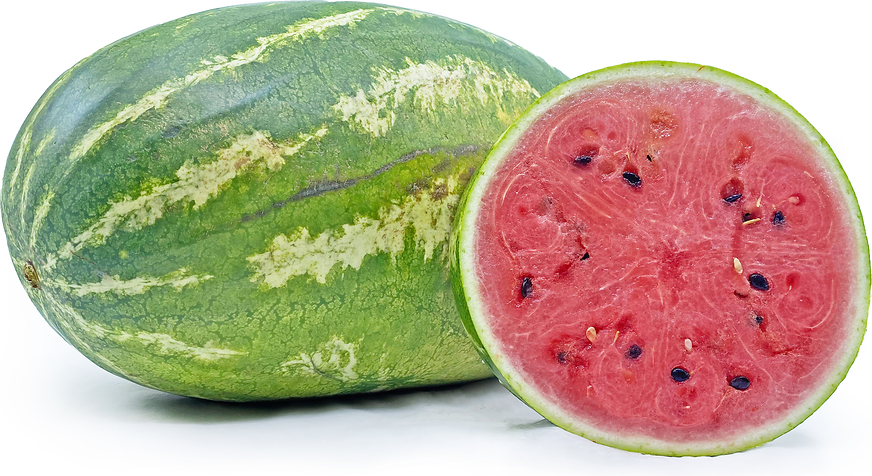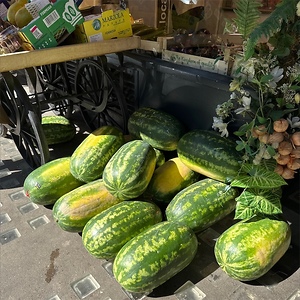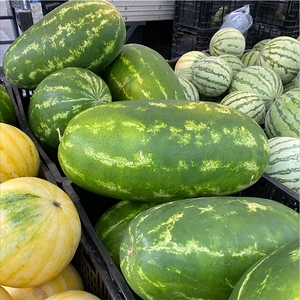


Sangria Watermelons
Estimated Inventory, ea : 0
Description/Taste
Sangria watermelons are large, oval to oblong fruits, averaging 17 to 25 centimeters in diameter. The rind is smooth, firm, and dark green, covered in light green, broken stripes, and mottling. Underneath the surface, the thin portion of rind that connects to the flesh is white, crunchy, and edible with a vegetal, cucumber-like flavor. The flesh is dark red, dense, aqueous, and crisp, encasing many black-brown, flat seeds. Sangria watermelons are known for their smooth-grained texture and have a high sugar content emitting a sweet, subtly fruity flavor.
Seasons/Availability
Sangria watermelons are available in the summer through early fall.
Current Facts
Sangria watermelons, botanically classified as Citrullus lanatus, are one of the most popular hybrid varieties for cultivation in the United States. The elongated, sugary-sweet fruits are descendants of the allsweet watermelon, which was a variety developed in the mid-20th century for its sweet flavor and resistance to disease. In the modern-day, the name allsweet has also become a category to describe multiple varieties of watermelons with very sweet and dense flesh. Sangria watermelons are widely grown for both commercial production and home garden cultivation. Growers favor the variety’s adaptability, uniform size and shape, consistent flavor, and improved disease resistance.
Nutritional Value
Sangria watermelons are an excellent source of lycopene, which is an antioxidant that gives the flesh its red hue and helps fight against free radicals within the body. The watermelons also are an excellent source of citrulline, which is converted into an amino acid that can help with wound healing, organ functioning, and blood vessel dilation. In addition to lycopene and citrulline, Sangria watermelons contain some vitamin A, copper, and potassium and are a good source of vitamin C, which is an antioxidant that can help strengthen the immune system and promote collagen production within the skin.
Applications
Sangria watermelons are best suited for raw applications as their juicy, sweet flesh is showcased when consumed fresh, out-of-hand. The flesh can be sliced into wedges and served as a dessert pizza, covered in soft cheeses and topped with herbs, nuts, and fresh berries, or it can be tossed into fruit and green salads. Sangria watermelons are also incorporated into gazpacho, used as a topping on bruschetta, chopped into salsa, or served on skewers with berries and cheese as an appetizer. Beyond fresh eating, the watermelon slices can be grilled and served with smoked salt or honey, blended into smoothies, slushies, and sorbet, or cooked into jellies and syrups. Sangria watermelons pair well with cheeses such as cotija, feta, and goat, herbs such as cilantro, basil, and mint, fruits such as blackberries, blueberries, coconut, and peaches, ginger, arugula, lime, and nuts such as hazelnuts or pistachios. Whole watermelons can be stored at room temperature for 1-2 weeks. When cut, the slices should be stored in a sealed container for up to four days.
Ethnic/Cultural Info
In the United States, there are six states with cities that proclaim themselves as the “watermelon capital of the world.” One of the cities, Cordele, located in Georgia, has been using this title since 1949 when it officially launched the Watermelon Days Festival. This month-long event takes place each June and celebrates the varieties of watermelon grown locally. During the festival, both Cordele residents and visitors participate in watermelon decorating contests, watermelon throwing competitions, seed spitting contests, and sample craft food and drinks made from the fruit. Cordele also has an automotive racetrack in the shape of an oval, similar to a watermelon, that is named the Watermelon Capital Speedway.
Geography/History
Sangria watermelons were created in the United States by breeder T.V. Williams during the late 20th century. The variety was developed from the allsweet watermelon and was selectively bred as an F1 hybrid seed to exhibit high yields, improved resistance to disease, and have a uniform shape, flavor, and size. Today Sangria watermelons are commercially cultivated throughout the United States and can be found through specialty grocers and farmer’s markets. The variety is also available through national seed retailers for home garden use.









